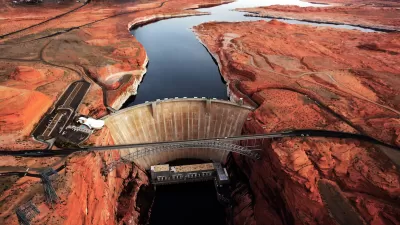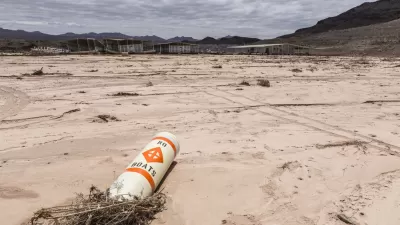Lake Powell levels could dip below the dam’s capacity to generate electricity, cutting off one of the Southwest’s most important power sources.

A piece by Jonathan Thompson highlights the crisis facing Lake Powell, which, as Planetizen has previously amplified, has reached its lowest level since Glen Canyon Dam was first constructed. “In March, Lake Powell’s surface level dropped to within 33 feet of the minimum needed to generate hydropower, for the first time since it was filled in the 1960s. If — or when — it hits that critical point, the Southwest power grid will lose one of its biggest electricity generators, as well as an indispensable backup power source.”
“Over the last few months, federal officials have attempted to stave off the power plant’s obsolescence by increasing releases from upstream dams and by sending less water downstream. But that failed to buoy reservoir levels, so now they have embarked on an effort to install turbines river outlet tubes lower on the dam, which would allow hydroelectricity generation to continue below minimum power pool — for a while.”
At full capacity, Glen Canyon Dam produces 1,300 megawatts of power. “In the 1990s, the dam produced as much as 7,000 gigawatt hours per year, enough to power nearly 600,000 homes. Last year, it was down to just 3,000 gigawatt hours.” Losing the power generated by the dam would increase costs, particularly for tribal nations. “The Navajo Tribal Utility Authority’s yearly power bill could jump by as much as $1.3 million, according to a 2016 consultant’s study, and nine other tribes would also see significant cost increases.”
FULL STORY: Powell’s looming power problem

Alabama: Trump Terminates Settlements for Black Communities Harmed By Raw Sewage
Trump deemed the landmark civil rights agreement “illegal DEI and environmental justice policy.”

Planetizen Federal Action Tracker
A weekly monitor of how Trump’s orders and actions are impacting planners and planning in America.

Why Should We Subsidize Public Transportation?
Many public transit agencies face financial stress due to rising costs, declining fare revenue, and declining subsidies. Transit advocates must provide a strong business case for increasing public transit funding.

Understanding Road Diets
An explainer from Momentum highlights the advantages of reducing vehicle lanes in favor of more bike, transit, and pedestrian infrastructure.

New California Law Regulates Warehouse Pollution
A new law tightens building and emissions regulations for large distribution warehouses to mitigate air pollution and traffic in surrounding communities.

Phoenix Announces Opening Date for Light Rail Extension
The South Central extension will connect South Phoenix to downtown and other major hubs starting on June 7.
Urban Design for Planners 1: Software Tools
This six-course series explores essential urban design concepts using open source software and equips planners with the tools they need to participate fully in the urban design process.
Planning for Universal Design
Learn the tools for implementing Universal Design in planning regulations.
Caltrans
Smith Gee Studio
Institute for Housing and Urban Development Studies (IHS)
City of Grandview
Harvard GSD Executive Education
Toledo-Lucas County Plan Commissions
Salt Lake City
NYU Wagner Graduate School of Public Service





























